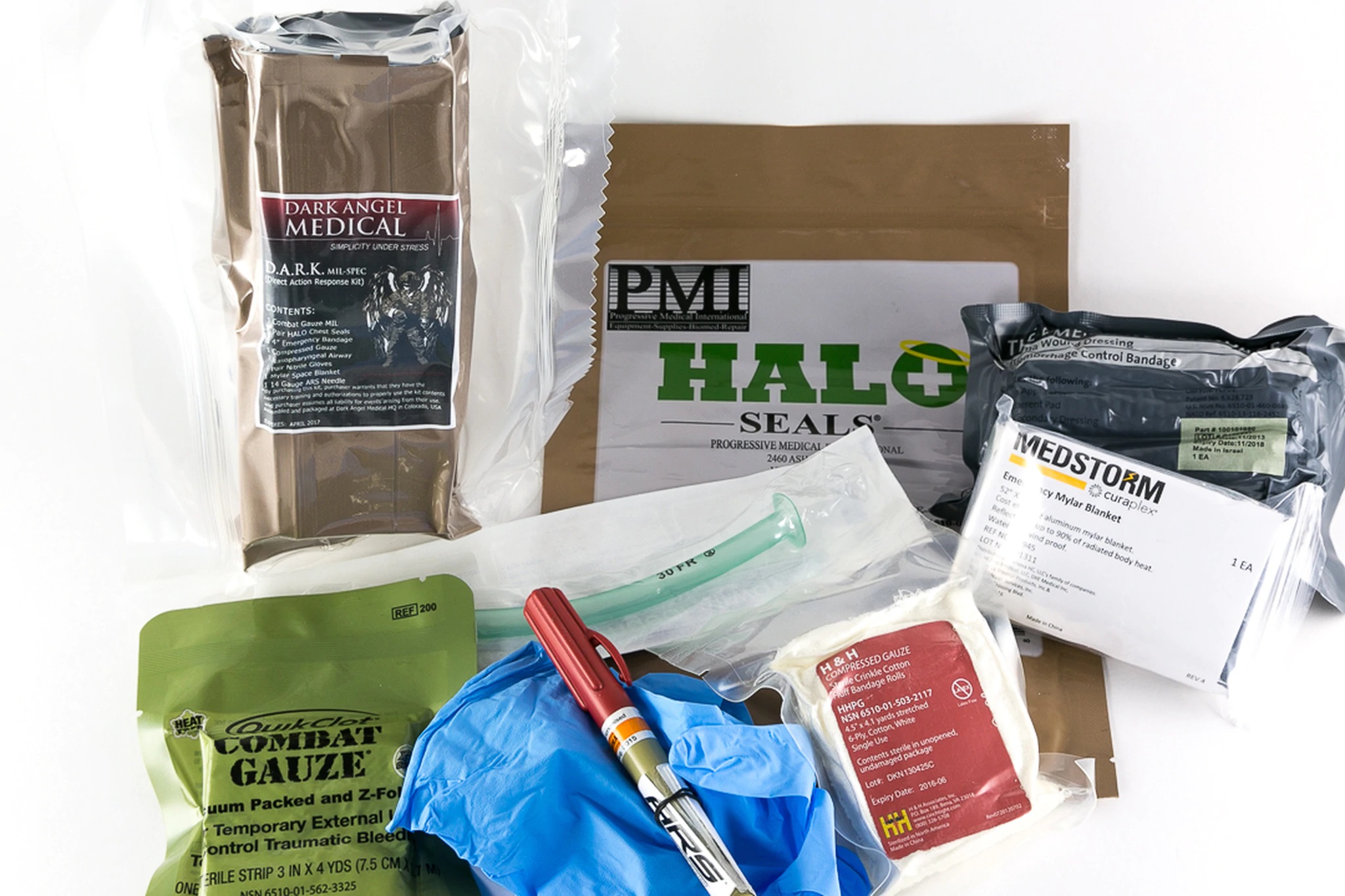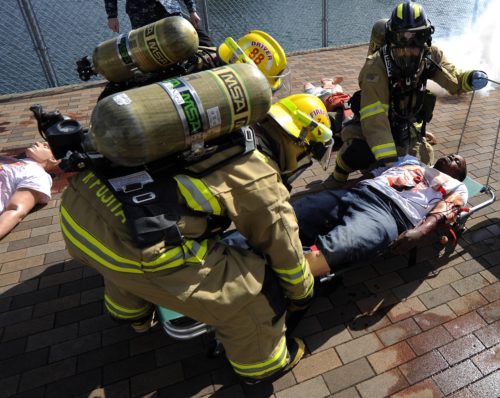
According to published research (JAMA Surgery, October 2017), the average response time in the US from the time of a 911 call to arrival of EMS on scene was seven minutes. This increased to more than 14 minutes in rural settings. A person can bleed out from a severed femoral artery in less than five minutes. You do the math.
In an active shooter or terrorist incident, emergency personnel won’t reach victims until the threat has been neutralized. During the Paris attacks in November 2015, it was over 160 minutes from the time the terrorists fired the first shots in the Bataclan theater until the first responders were able to reach those inside the venue.
The simple fact is that you’re your own first responder. A trauma kit containing at least a tourniquet and hemostatic agent needs to be part of your everyday carry.
Although a first aid kit may have some trauma care items, a first aid kit isn’t a trauma kit. A trauma kit is specifically designed to treat life threatening injuries. A first aid kit is geared toward the treatment of more minor, non-life threatening injuries. It’s important to have both, since each fulfils a different role.
Trauma Kit
When purchasing or putting together a trauma kit, stick to the basics. Just remember “Stop the Bleeding, Start the Breathing.” There’s obviously a lot more to emergency first aid, but those are the most immediate concerns. And those immediate concerns are what a trauma kit is intended to address. Your goal is to stabilize the patient until EMS arrives.
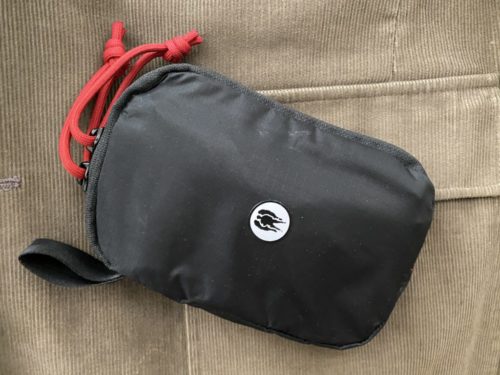
It’s a well-known axiom in combat medicine that the complexity of a trauma kit is inversely proportional to a munufacturer’s or operator’s actual combat medical experience. Keep your med kit simple.
An EDC trauma kit should be lightweight, compact and easy to use. It needs to be convenient to carry on your person. If it’s not convenient and easy to carry, you probably won’t have it with you when you need it. When life is measured in seconds, having a med kit in your car or range bag isn’t enough. The life you save may be your own.
I keep a larger trauma kit in my vehicle and range bag and keep a compact trauma kit on my person. I also keep a separate first aid kit in my vehicle and range bag. That way I am prepared for any contingency.
The Two Leading Causes of Preventable Trauma Deaths
The number one cause of preventable trauma deaths is exsanguination (severe loss of blood). Approximately 20% of people who have died from traumatic injuries could have survived with quick bleeding control. The only thing more tragic than a death from bleeding is a death that could have been prevented.
Tension pneumothorax is the second leading cause of preventable deaths. It’s the progressive build-up of air within the pleural space between the lung and the chest wall. Although tension pneumothorax normally develops over one to two hours, it can develop rapidly. It’s 100% fatal if not treated. The only treatment when it occurs is a needle thoracostomy (needle decompression) performed by skilled medical personnel.
Tourniquets
Tourniquets have emerged as the standard of care in the tactical environment due to their ease of use, rapid application, and complete stoppage of blood loss. Current protocol considers the tourniquet an initial lifesaving intervention to control massive hemorrhage from an extremity.
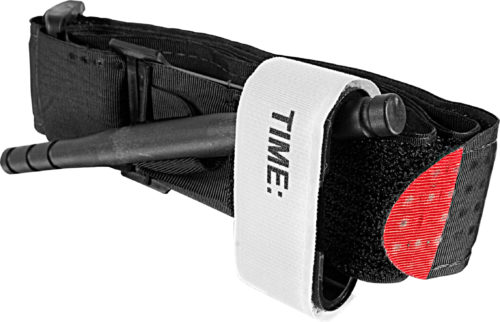
The old dogma of “save a life, lose a limb” has been proven to be false. A tourniquet can remain in place for two to four hours. Thousands of combat veterans are walking around today with all their limbs because their lives were saved by tourniquet use.
Popular commercial tourniquets include the Combat Application Tourniquet (C-A-T®) SOF® Tourniquet, RevMedx® TX® Series, Ratcheting Medical Tourniquet -Tactical (RMT-T™), SAM Extremity Tourniquet (SAM-XT™), Tactical Mechanical Tourniquet (TMT™), and WAT-T®. Each has its pros and cons.
The C-A-T, RMT-T, SAM-XT, SOF Tourniquet (SOFTT-W), TMT and TX Series (TX2 and TX3) are the only tactical tourniquets the US military Committee on Tactical Combat Casualty Care (CoTCCC) currently recommends. It’s important to keep in mind that the CoTCCC is looking at tourniquets for adults in a combat setting, not in a civilian setting or involving children.
The C-A-T, RMT-T, SAM-XT, SOF Tourniquet, TMT and TX Series are windless/ratcheting tourniquets. The SWAT-T is an elastic wrap tourniquets. The main advantage to elastic wrap tourniquets is that they pack down into a significantly smaller size, making them easier to carry. They’re also considerably less expensive than windless/ratcheting tourniquets. The best tourniquet is the tourniquet you have with you when you need it and the one that you have trained with.
The SWAT-T (Stretch, Wrap and Tuck Tourniquet) is a medical multi-tool that may be employed as a tourniquet, pressure dressing, occlusive device, elastic bandage, sling and swathe, and more. It can be successfully employed for higher axillary and groin applications. The latter should be true for the R.A.T.S., as well.
The SWAT-T can be employed for pediatric and K-9 applications, where standard windlass tourniquets cannot. It should be noted that North American Rescue states that the C-A-T has been shown to be effective on limbs as small as five inches in circumference. It should also be noted that the TX Series ratcheting tourniquet is available in a pediatric model designed specifically for children.
I recommend carrying at least two tourniquets. This will leverage your capability in a trauma incident.
Hemostatic Agents
Not all wounds lend themselves to tourniquet use. For bleeding that can’t be stopped only by compression and isn’t amenable to tourniquet placement, a hemostatic (clotting) agent should be used (with certain caveats).
Hemostatic agents (compounds that promote clotting) are designed to stop bleeding more quickly than traditional direct pressure. This doesn’t mean they are without controversy. While the general consensus is that these agents are a valuable adjunct to the effort to stop blood loss, some see less value in their use.
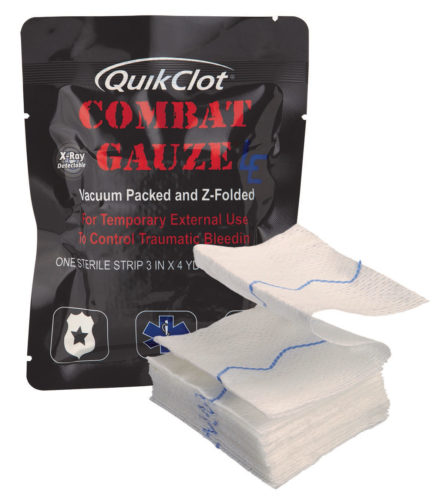
The overall answer may be that, when it comes to these products, they must be thought of as an addition to the means to the end. No hemostatic agent alone can stop significant bleeding. All must be coupled with direct pressure and the principles of blood pressure, blood flow, blood clotting, and most importantly, proper training.
When applied in conjunction with pressure, the product can accelerate clotting and ideally stop bleeding. Such agents work very well as the material used to pack deep wounds. When combined with surface pressure or a compression bandage, the results are almost always favorable.
Controlling blood loss can be a major problem for some individuals, particularly those who take blood thinners and those who suffer from inherited or acquired bleeding or clotting disorders. The blood in these individuals doesn’t clot quickly. Even the smallest cut can be a real problem. Hemostatic agents may be a valuable addition to controlling bleeding in these patients.
Hemostatic agents are employed for compressible (external) hemorrhage not amenable to limb tourniquet use or as an adjunct to tourniquet removal when evacuation time is anticipated to be longer than two hours. They’re primarily employed to control life-threatening bleeds in the junctional areas of the body. (think of where body parts meet the trunk, i.e., base of the neck, armpits and groin). They’re NOT for use in penetrating thoracic or head trauma. They can be used for deep lacerations if pleural or peritoneal space hasn’t been breached.
Several brands are available commercially. All of them perform well on heavy bleeds. The latest generation of hemostatic products perform significantly better than earlier generations. The shelf life of these products is related to sterility, not efficacy.
Z-Medica® OuikClot Combat Gauze®, CELOX® Gauze and ChitoGauze® are CoTCCC approved hemostatic dressings. They work by different modalities.
Current QuikClot products are Kaolin-based. They don’t create heat. Kaolin is a clay mineral. It works by activating the body’s own clotting cascade.
CELOX and ChitoGauze is chitosan-based. Chitosan is derived from the material that makes up shrimp shells but is non-allergenic. It forms a gel-like clot when it comes into contact with blood.
RevMedx XGAUZE® and XSTAT® are also options for hemostasis. They utilize small cellulose sponges that adsorb and rapidly expand on contact with blood to provide hemostatic pressure. They don’t require external compression, making them suitable for use on non-compressible wounds.
XGAUZE is the only self-expanding gauze on the market. Compressed sponges embedded in XGAUZE rapidly absorb blood and expand to ten times their original size. According to RevMedX, one expanded XGAUZE fills the same volume as three standard gauze dressings. It simplifies wound packing, reducing application time by 40% compared to standard gauze dressings. XGAUZE is now standard issue for the US Army Combat Medic Kit
XSTAT is the only injectable wound treatment designed to control hemorrage from penetrating wounds, such as gunshot and knife wounds. It works by injecting the sponges directly into a wound cavity using a syringe-like applicator. XSTAT is available in two applicator sizes: XSTAT 30 Gen 2 and smaller XSTAT 12. The XSTAT 12 is designed to treat life-threatening bleeding from penetrating wounds in junctional areas that may to narrow to access with the larger XSTAT 30. According to RevMedX, XSTAT can stop bleeding in seconds to stabilize injuries until patients reach an emergency facility.
Pressure Bandages
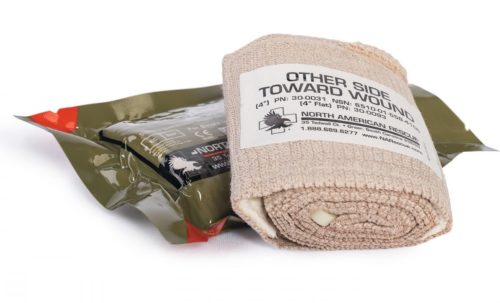
A pressure bandage should also be part of your kit. It’s utilized to direct and maintain pressure on a wound when hemorrhage is controlled or for venous or capillary oozing with the goal of creating enough pressure to stop the bleeding. It reinforces wound packing. When utilizing any pressure bandage, beware of tourniquet effect, which can occur if the bandage is applied too tightly. Always assess distal pulse after application.
Many types of pressure bandages are available commercially. Popular pressure bandages include the North American Rescue Emergency Trauma Dressing (ETD®), Tac Med Solutions OLAES Modular Bandage and Israeli Bandage or “Izzy.”
Occlusive Dressings
Laypersons can treat penetrating chest injuries (sucking chest wounds) by the application of an occlusive dressing. These chest seals may slow the development of tension pneumothorax and allow for better breathing. All penetrating chest wounds need to be treated.
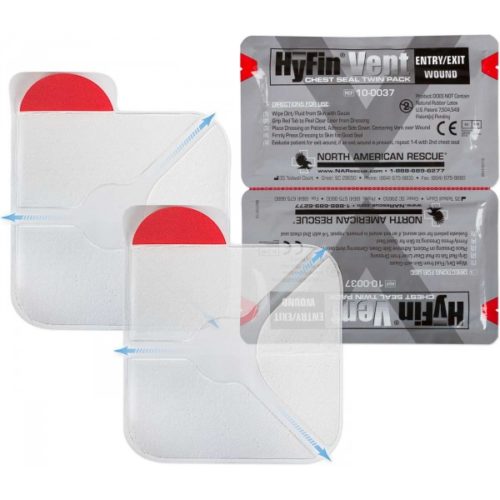
Occlusive dressings are designed to form a barrier and prevent outside air from entering the pleural cavity from an open pneumothorax (sucking chest wound). Many types of occlusive dressings are available, including the HALO® Chest Seal, HyFin® Chest Seal, Asherman Chest Seal (ACS), FOX Chest Seal, Bolin Chest Seal, and Vaseline® Gauze. Although used by the armed forces, the ACS doesn’t stick as well as the newer designs and the valve is prone to clogging. Carry at least two chest seals to treat both entrance and exit wounds.
Most trauma kits don’t come standard with a chest decompression needle. Needle decompression is an advanced skill. If you have the authorization, training and the need, a “chest dart.” such as the excellent North American Rescue A.R.S., can be added.
Nasopharyngeal Airway
A nasopharyngeal airway (NPA) for the airway management of patients is another valuable addition to any trauma kit. It’s considered important enough to now be included in the US military Individual First Aid Kit (IFAK). They’re available from several companies. One of most common is made by Rusch®.
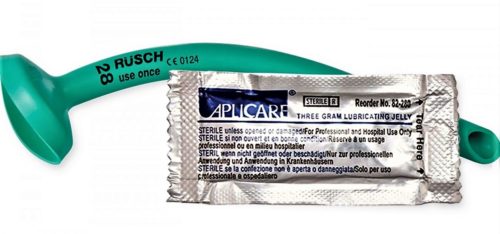
Use a NPA only in unconscious victims who cannot protect their airway — check blink reflex. It’s used to keep the airway open.
A NPA shouldn’t be used in conscious patients due to the potential of engaging the gag reflex, causing vomiting with possible aspiration.
The NPA must be sized properly for the patient. It’s NOT for use where there’s suspected skull base fractures, severe facial trauma or nose bleed.
Prior to insertion, measure it from the ear lobe through to the tip of the nose. A safety pin can be inserted through the NPA to mark proper depth of insertion. Compare the NPA to little finger of victim for diameter check. The average NPA diameter for an adult is 28F. A NPA can also be used as an expedient OPA if need be.
Personal Protective Equipment
Personal Protective Equipment (PPE) is essential to protect yourself from the risk of infection from bloodborne pathogens. Nitrile (latex-free) gloves are a must. A significant percentage of the population has a latex allergy. Gloves are the first thing on and the last thing off.
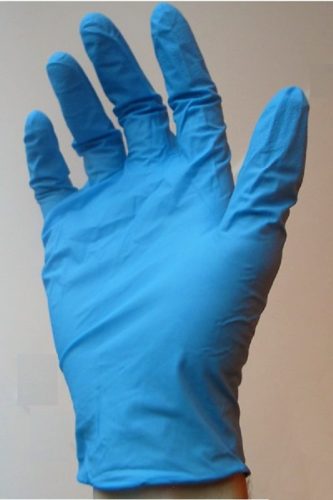
Eye and face protection is also important. The ReadiMask® Adhesive Sealing Particle Mask with Anti-Fog Eye Shield that’s manufactured by Global Safety first, LLC is excellent in this regard.
A barrier device for mouth-to-mask rescue breathing, is also good to include.
Other Considerations
Other items that you may wish to include are trauma shears or a safety cutter, a space blanket, and a polycarbonate eye shield and tape.
Training is Essential
Having the necessary tools is only part of the equation. Equipment is only as good as your training. Basic emergency medical training should cover the entire spectrum of lifesaving skills. And like shooting, they’re perishable skills.
Emergency medical training should be part of the basic skill sets of every firearms owner. In fact, it should be part of the basic skill sets of everyone. The time to learn how to use a trauma kit isn’t when someone is bleeding out.
The National Association of Emergency Medical Technicians (NAEMT) and STOP THE BLEED® are excellent resources that can direct you to courses in your area.
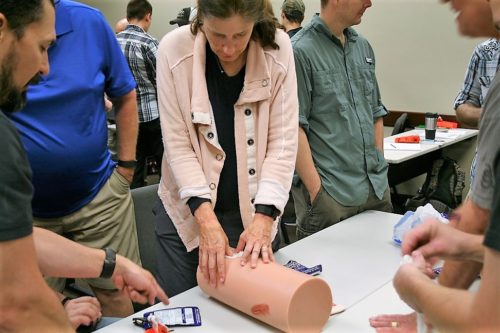
Dark Angel Medical offers their outstanding two-day Direct Action Response Training (D.A.R.T.) course at various locations around the country. All participants receive BCON (Bleeding Control) certification from the American College of Surgeons. It also provides 16 hours of CEU’s, per CECBEMS, to NREMT EMT-Basics/Advanced and Paramedics. I have taken the D.A.R.T. course and highly recommend it.
Dark Angel Medical also offers a free online introductory course designed to teach the basics of bleeding control, as well as numerous trauma kits and components. Dark Angel trauma kits are exceptionally well thought out and second to none. If you ever have to use one of Dark Angel Medical’s kits to save a life, they’ll replace any components used for free!
Kerry Davis, founder of Dark Angel Medical, joined the US Air Force in 1991 and served until 2007 as an ER medic, flight medic and officer training school instructor. He attended US Army Airborne School at Ft. Benning, Georgia while stationed as a flight medic at Pope Field in Ft. Bragg, North Carolina. He subsequently worked as a civilian paramedic and completed his RN. He has worked as a critical care and emergency room RN since 2003. He has instructed with Magpul® Dynamics and as a part-time instructor with SIG Sauer® Academy.
The online learning platform Deployed Medicine is another useful resource. It’s used by the Defense Health Agency (DHA) “to trial new innovative learning models aimed at improving readiness and performance of deployed military medical personnel.” Learning assets include the standardized Tactical Combat Casualty Care All Service Members Course (TCCC ASM) curriculum developed by the Joint Trauma System, which is part of the DHA.
*The views and opinions expressed on this website are solely those of the original authors and contributors. These views and opinions do not necessarily represent those of Spotter Up Magazine, the administrative staff, and/or any/all contributors to this site.
